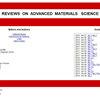超声波辅助磨削γ-TiAl 金属间化合物的参数优化:带有表面完整性评估的灰色关系分析方法
IF 3.9
4区 材料科学
Q2 MATERIALS SCIENCE, MULTIDISCIPLINARY
引用次数: 0
摘要
γ-TiAl金属间化合物(Ti-45Al-2Mn-2Nb)的加工对飞机发动机部件的制造至关重要,而众所周知,这些部件的加工性极具挑战性。本研究通过超声辅助磨削实验对γ-TiAl 金属间化合物的加工性能进行了深入研究。研究了各种磨削参数,如砂轮转速(v s)、进给率(v w)、磨削深度(a p)和超声波振幅(A),以了解它们对磨削力、温度和表面质量的影响。采用灰色关系分析法(GRA)和方差分析法分析实验数据,确定超声辅助磨削γ-TiAl 金属间化合物的最佳加工参数。此外,还评估了加工后的表面完整性,包括表面粗糙度、形貌和残余应力。通过 GRA 确定的最佳磨削参数组合为 F n = 3.22 N,F t = 1.08 N,T = 174°C。在选定的加工条件下,切削深度对磨削力和温度的影响最大,而砂轮速度的影响最小。工件表面粗糙度(Ra)随进给速度和切削深度的增加而增加,但随砂轮速度的增加而逐渐降低。施加超声波振动后,表面粗糙度明显下降,降幅在 20.12% 至 7.67% 之间。然而,砂轮速度、切削深度和进给量的增加抑制了超声波振动导致的粗糙度降低。超声波振动有效降低了工件表面的轮廓高度,在所选范围内最大降低了 1.94 μm。然而,随着砂轮速度、切削深度和进给量的增加,这种降低的效果逐渐减弱。本文章由计算机程序翻译,如有差异,请以英文原文为准。
Parameter optimization for ultrasonic-assisted grinding of γ-TiAl intermetallics: A gray relational analysis approach with surface integrity evaluation
The processing of γ-TiAl intermetallic compound (Ti–45Al–2Mn–2Nb) is essential for manufacturing aircraft engine components, known for their challenging machinability. This study delved into the machining performance of γ-TiAl intermetallic compound through ultrasonically assisted grinding experiments. Various grinding parameters, such as wheel rotation speed (v s ), feed rate (v w ), depth of grinding (a p ), and ultrasonic amplitude (A ), were investigated to understand their effects on grinding forces, temperatures, and surface quality. Gray relational analysis (GRA) and analysis of variance were used to analyze experimental data and ascertain the optimal machining parameters for ultrasonically assisted grinding of γ-TiAl intermetallic compound. Additionally, post-processing surface integrity, encompassing surface roughness, morphology, and residual stresses, was evaluated. The optimal grinding parameter combination was determined as F n = 3.22 N, F t = 1.08 N, and T = 174°C through GRA. Under the selected machining conditions, the depth of cut exerted the most significant influence on the grinding force and temperature, while the effect of wheel speed was the weakest. The surface roughness (Ra) of the workpiece increased with increasing feed rate and depth of the cut but decreased gradually with increasing wheel speed. Upon applying ultrasonic vibration, there was a notable decrease in surface roughness, ranging from 20.12 to 7.67%. However, the increase in the wheel speed, depth of cut, and feed rate inhibited the reduction of roughness due to ultrasonic vibration. Ultrasonic vibration effectively reduced the profile height of the workpiece surface, with a maximum reduction of 1.94 μm within the selected range. Nonetheless, as the wheel speed, depth of cut, and feed rate increased, the effectiveness of this reduction gradually diminished.
求助全文
通过发布文献求助,成功后即可免费获取论文全文。
去求助
来源期刊

Reviews on Advanced Materials Science
工程技术-材料科学:综合
CiteScore
5.10
自引率
11.10%
发文量
43
审稿时长
3.5 months
期刊介绍:
Reviews on Advanced Materials Science is a fully peer-reviewed, open access, electronic journal that publishes significant, original and relevant works in the area of theoretical and experimental studies of advanced materials. The journal provides the readers with free, instant, and permanent access to all content worldwide; and the authors with extensive promotion of published articles, long-time preservation, language-correction services, no space constraints and immediate publication.
Reviews on Advanced Materials Science is listed inter alia by Clarivate Analytics (formerly Thomson Reuters) - Current Contents/Physical, Chemical, and Earth Sciences (CC/PC&ES), JCR and SCIE. Our standard policy requires each paper to be reviewed by at least two Referees and the peer-review process is single-blind.
 求助内容:
求助内容: 应助结果提醒方式:
应助结果提醒方式:


